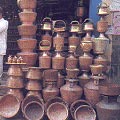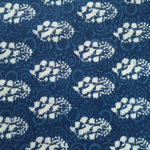Kans or kayen is the local name of an alloy of two metals – copper and tin – that is used in making dishes called dakayen. The kans metal alloys are used in making domestic utensils – such as bowls and cooking utensils – and utilitarian items such as lamp stands by the process of metal casting. Dishes hand-crafted by hammering and heating were traditionally an integral part of every household; there is reason to believe that the forging of these kans plates is a unique centuries-old technique. However, with the introduction of stainless steel tableware in recent times, these traditional kans metal dishes are gradually disappearing from most households.
PRACTITIONERS & LOCATIONS
These traditional kans dishes are produced by a special category of craftspersons locally known as kasa. These craftspersons, who live and work mainly in Pokhara, Lalitpur, and Kathmandu City, are noted for their remarkable skill and physical strength. Lalitpur, in Kathmandu, Palpa a district in western Nepal and Bhojpur, a district in eastern Nepal are production centres of a variety of this metalware.
RAW MATERIALS
The kans is an alloy of copper and tin (kayentha/rang) By varying the composition of copper and tin two alloys are made depending on the proportions used: kans and charesh both are used in the casting process. These alloys are prepared based on traditional, oral knowledge.

PROCESS, TECHNIQUE & TOOLS
The kans alloy of copper and tin (kayentha/rang) is placed in a clay crucible in the required proportion and then heated together on a high flame in an oven. For this, the bed of the oven is first filled with small pieces of charcoal, after which the crucible is placed over it with its mouth covered with a lid. When the fire is lit from below a blast of air is produced by the leather bellows, fitted on the two sides of the oven – this keeps the charcoal burning briskly.
The kasa frequently checks to see if the contents of the crucible are fully melted. This is done by shaking the crucible – and if there is a splashing sound inside the crucible it is assumed that the metal is in a molten state. Approximately 10 kg of kans is required to craft 20 dinner plates about 10″-12″ in diameter.
Circular brass moulds (pallas) of different sizes are made for casting discs of the alloyed kans metal. The pallas are often of different weights and sizes. When the molten metal is ready for casting, the red-hot crucible is held with tongs and the molten metal steadily poured into the pallas and allowed to cool. When the metal is cold and set these circular metal discs are removed from the moulds – at this point they are ready for hammering.
The most difficult part of the job is the hammering, a process that requires great skill, physical dexterity and perfect timing. Usually three or four kasas work together with clockwork timing and perfect harmony, completely in rhythm, when hammering the heated metal disc on an iron anvil. The work is divided, with one craftsperson holding the disc and keeping it set in the required position on the anvil, and when necessary, changing the position of the disc to facilitate its even hammering on all sides. While striking with their hammers, one of the other two kasas first hits the metal disc at a certain point, and his partner follows him in striking. As the metal gets cold during the process it is repeatedly placed in an open fireplace and made red-hot again. The hammering process is repeated and continued until the circular disc is flattened and attains the usual size of about 10″-12″ in diameter. As is obvious, the hammering and heating need perfect teamwork.
The rough plate is now ready for the next stage – shaping the edges. For this, the kasa workers use stone moulds that are carved in the shape of the edges required. The circular plates are first reheated over the fire until red-hot and then placed over the stone mould. The craftspersons bend these red-hot plates with an iron hammer by placing the edges of the plates over the carved moulds and by repeated heating and hammering, till the edges of the dishes are shaped in proportion to the desired shapes and sizes.
During the process of hammering the craftsmen are constantly aware that excess heat causes the metal discs to develop cracks. The kasas work without using any high-tech measuring devices – it is only experience and judgement that helps them determine the right temperature.
When the dishes are ready, they are tempered in the traditional way by making a paste of common salt and ordinary grey-coloured clay in a ratio of about 1:8. This paste is applied to the dishes on the inner sides only and dried in the air. The dishes are then heated over the fire with only the inner sides exposed to the heat – for uniform heating they are constantly rotated by means of two iron rods. When the right temperature is reached the dishes are plunged into water, and taken out immediately. This process is called ‘giving the pine’ or tempering. This helps to improve the malleability of the dishes.
Dishes that have been tempered develop a dark-red colour on the inside and are blackish on the outside. For the final finishing and polishing the dishes are attached to a wooden lathe-machine and turned and given a shiny surface with the use of different kinds of iron files. Mild forging is done in these wares to add a decorative element.
These tools are prepared by the local blacksmiths who are specialists in the art of making tools for the metal-workers.
CONTEMPORARY DEVELOPMENTS
In the past few decades some rolling mills have been set up at Balaju Industrial District, Kathmandu, and the Patan Industrial Estate – these produce kans metal sheets of the required shapes and sizes. The kasas can now eliminate one of the steps of production by purchasing the circular metal sheets required from the local mills.
Gallery
YOUR VIEWS
PRACTITIONERS: INDIA
Access 70,000+ practitioners in 2500+ crafts across India.
BIBLIOGRAPHY
10,000+ listings on arts, crafts, design, heritage, culture etc.
GLOSSARY
Rich and often unfamiliar vocabulary of crafts and textiles.
SHOP at India InCH
Needs to be written.





